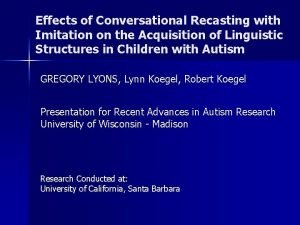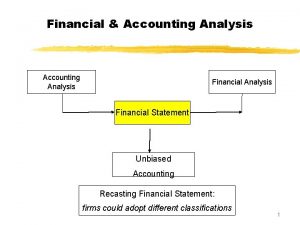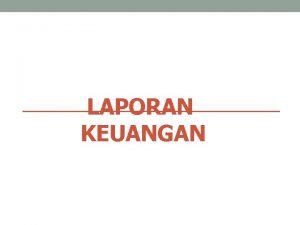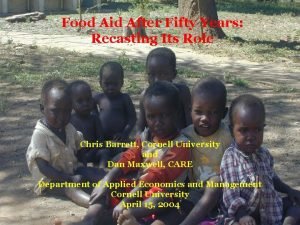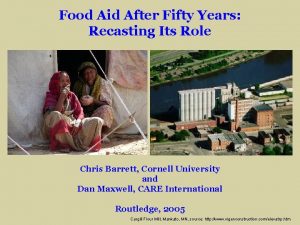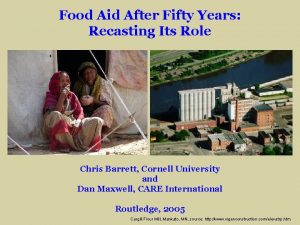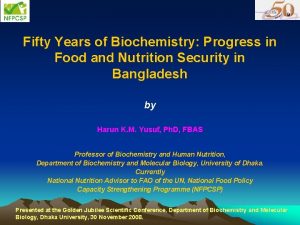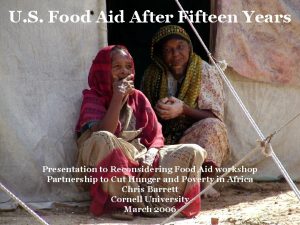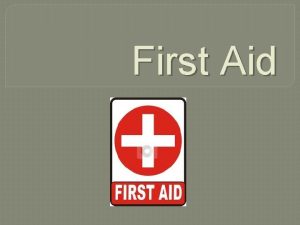Food Aid After Fifty Years Recasting Its Role














- Slides: 14

Food Aid After Fifty Years: Recasting Its Role in Support of MDG#1 Chris Barrett, Cornell University Presentation to Senior Executives of Catholic Relief Services Baltimore, MD May 19, 2005

Food aid in support of MDG #1 Millenium Development Goal #1: Reduce by half the proportion of people (i) living on less than a dollar a day and (ii) who suffer from hunger. What role for food aid? - Save lives - Fulfill human right to food - Protect assets (especially human health) - Facilitate productivity and asset growth where food availability and poor market performance are limiting. Food aid is a complement to other resources. Need to embed food aid in development strategy, not fit development strategies to food aid policies.

Food aid in support of MDG #1 Yet food aid’s effectiveness in advancing MDG #1 depends on: - Whether it is focused on this goal. Given a tight budget constraint, need to use resource efficiently. - How it is managed by operational agencies: - Efficacy of targeting and timing - Whether it creates net disincentive effects that trade long-term losses for short-term gains - Procurement and supply chain management - Whether food is the right resource for a given problem

Suddenly food aid is a big issue again International level: • WTO negotiations: food aid a major point of dispute in export competition pillar • FAC renegotiation stalled … presently on short-term extensions • CSSD efficacy has collapsed (less than 5% reported) • GMO disputes (India, Zambia, Zimbabwe ) • Recent crises and extraordinary emergency funding needs – Ethiopia 2003 ($500 mn US food aid; $5 mn ag dev’t assistance) – S. Africa: 2002 -3 (HIV and drought) – Darfur: 2003 -present (near halving of rations) Domestically: • FY 2006 budget and $300 million proposal • Crisis in non-emergency Title II funding • Renewed battles over monetization, cargo preference • Mc. Govern-Dole GFEI and USDA-USAID turf battles

Food aid’s first fifty years: A donor-driven resource Modern Food Aid’s Origins: - Began in 1954 with Public Law 480 (PL 480) in the U. S. The U. S. and Canada accounted for >90% of global flows through early 1970 s. In EC as well, food aid was surplus disposal. - Governed by CSSD and FAC, designed for a different era of food aid with a donor focus. - Aimed at multiple donor goals – gov’t surplus disposal, domestic farm support, export promotion, support maritime industry, and geopolitical leverage as well as development and humanitarian goals … this violates the Tinbergen Principle (1 instrument/policy goal).

Food aid’s first fifty years: A donor-driven resource Donor-driven food aid is based on a few key myths: Myth: Food aid effectively supports donor country farmers (~0. 05% of US food economy, bagging/processing requirements, etc. ) Myth: Food aid builds long-term commercial export markets (“free sample” analogy wrong) Myth: Cargo preference laws effectively support the U. S. maritime industry (50% decline/decade) Myth: Food aid is wholly additional (Engel’s law, MPC of food only 0. 3 -0. 8) Myths reduce food aid’s efficacy in advancing MDG#1 because encourage resource diversion. Must decouple food aid from other donor objectives.

Food aid’s first fifty years: A donor-driven resource So who benefits? i) Very small number of shippers (78% cargo preference premium, MSP) ii) Small number of food vendors (11% procurement premium, bagging/processing minima, BEHT storage fees) iii) NGOs (preferential access to resources via monetization)

So how to move food aid further towards a needs/rights-based system? Key NGOs can influence change if act soon: 1) Use WTO Ao. A negotiations in coming months to - define/convert towards best practice food aid - pin down resource commitments 2) Reform the multilateral food aid governance to give voice to recipients and operational agencies (a Global Food Aid Compact). 3) Advocacy for increased flexibility and push for wiser use of ODA resources in Farm Bill and FY 2006 budget process. 4) Operations-level improvements in targeting, information systems, markets analysis, supply chain management, monetization, etc.

WTO and Global Food Aid Compact Tied food aid Non-emergency food aid Emergency food aid Untied food aid Untargeted/ poorly targeted in d i a 1 Effectively d G# o Targeted o D f e M d fi of a rt n o o p B p su Objective: like Codex Alimentarius, use existing institutions’ technical expertise. But shift food aid towards food aid forms with greatest benefits to the poor and least trade distorting while maintaining value of flows.

Reform food aid governance Existing institutions no longer credible or effective. It’s not enough to remake their rules, location, etc. : 1. FAO Consultative Sub-Committee on Surplus Disposal (1954) - no legal authority, no enforcement - based on economic illogic of UMRs - reporting has fallen to <5% food aid flows 2. Food Aid Convention (1967) - donors-only club run from Int’l Grains Council - signatories breaching treaty routinely now 3. Uruguay Round Agreement on Agriculture (1994) - definition of tying differs from OECD/DAC - endorses UMR illogic, inconsistent with tying ban - ratifies FAC shipment minima without bolstering it 4. Self-regulation (e. g. , Bellmon and Trade Analyses) - conflict of interest problems in quality control

Advocacy: The Changing Face of US Food Aid Programs Title I has decreased more than 90% since 1980 in inflation-adjusted terms, while Title II has increased ~35%. Isn’t it time to consolidate US food aid under USAID and tighten the focus on food security?

Operational-Level Reforms by NGOs/WFP Recasting Food Aid Decision Tree For Appropriate Food Aid Response Are Local Food Markets Functioning Well? Yes Provide cash transfers or jobs to targeted recipients, not food. No Is There Sufficient Food Available Nearby To Fill The Gap? Yes Provide food aid based on local purchases/ triangular transactions. No Provide food aid based on intercontinental shipments.

Conclusions 1. Food aid is an essential tool for addressing MDG #1. 2. But, need to decouple it from other, donor-oriented objectives that impede its developmental effectiveness. (Moreover, food aid is ineffective at advancing other goals. ) 3. Existing food aid governance institutions ineffective. Need reforms to end donors-only club approach. WTO essential to this goal. GFAC one viable option. 4. US food aid policy is the engine that drives global food aid. So long as US policy continues to mix motives, food aid will continue to be contentious and to underperform its considerable potential. 5. NGOs – especially CRS and a few others – could make an enormous difference if they became more active in advocacy and in making operations-level improvements.

Thank you for your time, attention and comments! C. B. Barrett and D. G. Maxwell, Food Aid After Fifty Years: Recasting Its Role (London: Routledge, 2005)
 Fifty days after easter
Fifty days after easter After me after me after me
After me after me after me John 14:1-3
John 14:1-3 Role play on healthy food and junk food
Role play on healthy food and junk food Of junk food
Of junk food Goat years to human years
Goat years to human years 300 solar years to lunar years
300 solar years to lunar years Four scores and seven years ago
Four scores and seven years ago Conversational recast
Conversational recast Cara menghitung bep
Cara menghitung bep Recasting in speech therapy
Recasting in speech therapy Operating roa
Operating roa Recasting laporan keuangan adalah
Recasting laporan keuangan adalah First aid merit badge first aid kit
First aid merit badge first aid kit Greenhill medical centre
Greenhill medical centre








